Behind the outbreak of the TWS Bluetooth chip: Three camps fight against the court, high imitation player Hua Qiangbei
Chi things “(ID: zhidxcom) , author: Wei Shiwei.
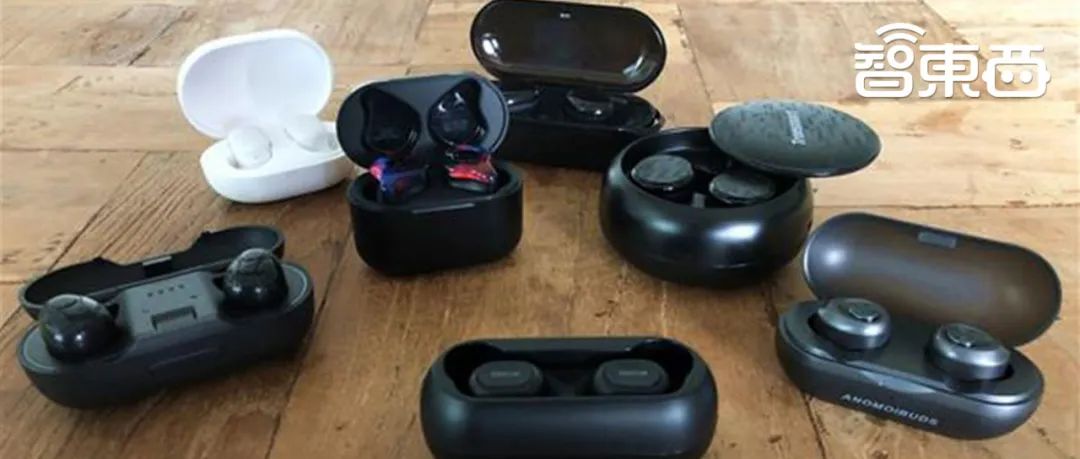
We set the hour hand back to the autumn of September three years ago.
On that day, Apple’s autumn new product launch came as scheduled. When Apple CEO Cook showed off a pair of wireless earphones like the traditional Apple headphones with the cables cut off on the stage that attracted thousands of people, maybe no one would have thought that this product that was “ridiculed” by the crowd when it was launched However, today, four years later, with an annual shipment of 100 million units, it has firmly occupied half of the market.
This product is named True Wireless Stereo (TWS) Bluetooth headset for AirPods.
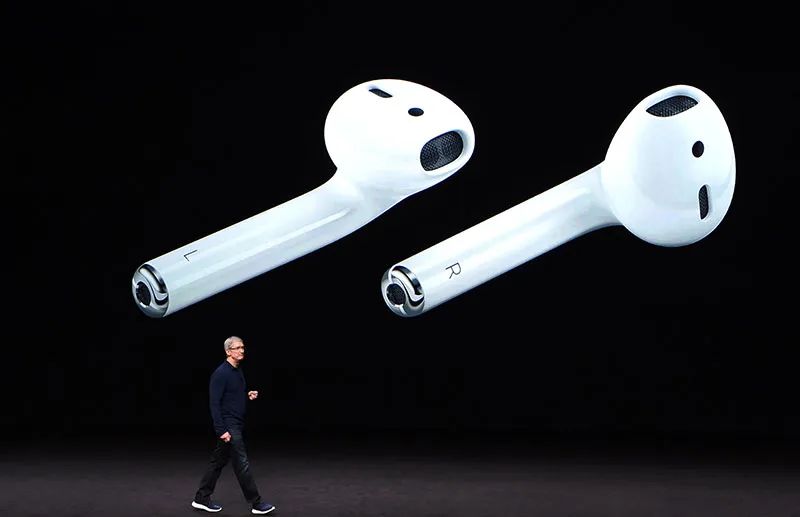
According to Apple’s first quarter 2020 financial report data, its net revenue of wearable devices, home products and accessories including AirPods was US $ 10.10 billion, a year-on-year increase of nearly 26.7% Shows the revenue and profit levels of many mobile phone companies.
The emergence of Apple AirPods has sparked a different spark in the Bluetooth headset market, and its development momentum has gradually shown the trend of Ebara. Market research agency Counterpoint Research estimates that 20Global TWS headset shipments totaled 120 million pairs in 19 years, and this data is expected to reach 230 million pairs in 2020 with the emergence of a new year’s replacement wave.
At the same time, market research institute GFK estimates that the market size of TWS headsets in 2020 will also expand from US $ 5.4 billion in 2018 to US $ 11 billion in 2020.

▲ Statistics and Forecast of Global TWS Headphone Market Shipment in 2016-2020 (Source: Counterpoint Research)
Behind the fire of TWS headsets, the most important fuse is undoubtedly the innovation and promotion of Bluetooth chip technology.
For a long time, Bluetooth chip is not only the core component to promote the development and application of Bluetooth headset technology, but also the market with the most intense supply chain competition. Today, the blowout development of the Bluetooth chip market is also closely related to the technological innovation of Android chip manufacturers.
After the Apple AirPods series of headphones swept the market in 2016, its unique low-power stereo Bluetooth chip patent has always been a technical barrier that traverses the ecosystem between Apple and Android. But in the past two years, as the third-party Bluetooth chip manufacturers continue to break through in technology, this barrier has finally been torn apart, and the TWS Bluetooth chip market has been ignited in an instant.
But for now, the TWS Bluetooth chip is becoming a mixed market. On the one hand, while mid- to high-end players such as Apple, Huawei, Hengxuan, and Luoda continue to explore a larger market, various types of Bluetooth chips and solutions are emerging endlessly. Unscrupulous entry into the low-end and “cottage” markets.
Not only that, from the two smart phone user groups of Apple and Android, to domestic and foreign Bluetooth chip manufacturers, to chip manufacturers, mobile phone manufacturers and headset manufacturers, there is also a fierce competition of Bluetooth. The battle of chips, While constantly stimulating the market and consumer nerves, it is also forcing the traditional headset industryIndustry accelerates innovation and transformation.
This time, Smart Things has conducted an in-depth investigation of the TWS Bluetooth chip market. While analyzing the current Bluetooth chip market structure, it also explores the market of important players from its outbreak path. Play style and “genre”. Under the seemingly promising development trend, what contradictions and challenges does it hide?
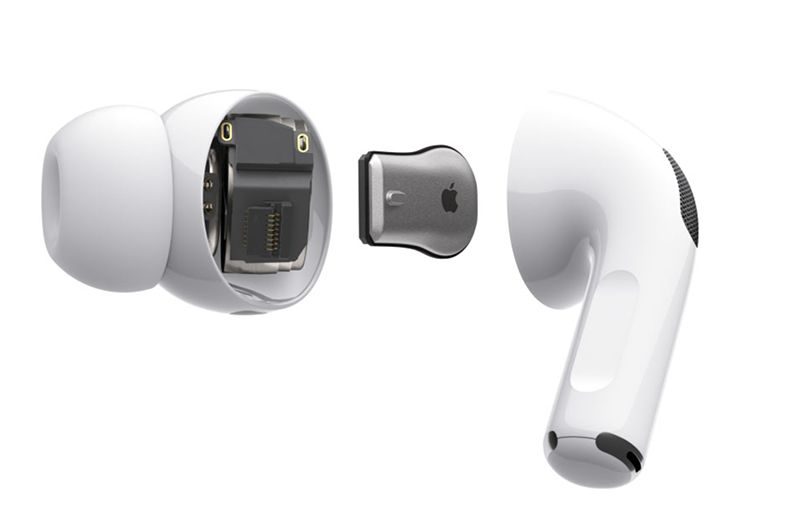
▲ H1 chip in Apple AirPods Pro
Apple AirPods: a newcomer to the TWS headset market
In fact, before Apple’s strong bid for the traditional headphone market in 2016, the traditional headphone market on the one hand was in a state of long-term saturation in the market, and on the other hand it was facing a lack of innovation.
Around 2015, brands such as AKG, Audio-Technica, Beats and Sennheiser are still the main players in the traditional earphone market. Headphones and in-ear products continue to suppress the presence of earphones. At the same time, Features such as noise reduction and built-in sound cards have also gradually increased.
But compared with smart phones and computers, the investment cost of earphone production was relatively small at the same time. At the same time, the technology threshold was low and the production cycle was short. As a result, a large number of small and medium manufacturers quickly poured in, and the low-end earphone market is gradually trending. saturation.
While traditional headphone makers are turning to the high-end market segment, a potential competitor born out of demand for home audio and video, smart speakers, is also gradually emerging.
In this pattern, although TWS headset-type products had already appeared at that time, it was still a market for niche manufacturers. In addition, there are also players who make stereo Bluetooth headsets, but the product still has a cable connection. The earphones launched by these manufacturers have only harvested a small wave of attention and have not caused widespread waves.

▲ Bluetooth headset introduced by Earin in 2015
The traditional headphone market at that time has been tepid, The turning point of all this will start from 2016.
In June 2016, the Bluetooth Technology Alliance (SIG) officially released the Bluetooth 5.0 standard. With the characteristics of faster transmission speed, longer transmission distance, and lower power consumption, it is giving the Internet of Things (IoT) While the market brings important technical momentum, it has also become a booster for the development of Bluetooth headsets.
It is at this node that Apple launched AirPods.
According to data reported by market research company Slice Intelligence, The first generation of AirPods earphones has just taken the market for a month, and has already won 26% of the market share of wireless earphones. The traditional earphone brands Jaybird and Plantronics are quite equal.
Behind AirPods, a Bluetooth chip called W1 plays a vital role.
The W1 chip, which was born with the first generation of AirPods headsets, has faster and more stable Bluetooth connection performance, and consumes only one-third the power of traditional Bluetooth chips. Although Apple has not revealed more information about the W1 chip, with its three major features, the W1 chip also brings a newer experience to AirPods.
In three years, AirPods shipments skyrocketed from 15 million pairs in 2017 to 60 million pairs in 2019, directly accounting for 71% of the TWS headset market.
At this point, a Bluetooth chip fight around the TWS headset slowly rolls out.
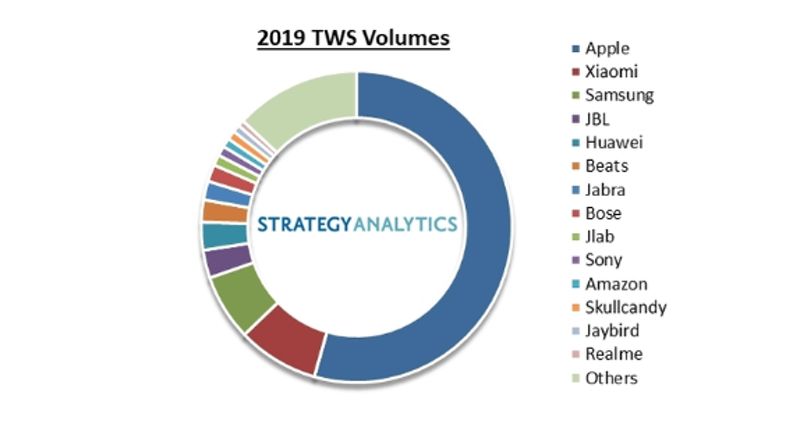
▲ TWS Bluetooth headset shipments in 2019 (Source: Strategy Analytics)
The high-school, low-end camps are fierce, and the Android market ecology is complicated
According to the market research organization Counterpoint Research, the global shipment of TWS Bluetooth headsets will reach 230 million pairs in 2020, an increase of 91.6% year-on-year. At the same time, the compound annual growth rate from 2019 to 2022 will remain at 80%, showing a blowout development.
In the recent years when the TWS headset market has doubled, downstream terminal manufacturers have swarmed in, and at the same time, it has brought huge demand for Bluetooth chips to upstream chip manufacturers, attracting a large number of players.
According to the data of Guosheng Securities’ market research report in 2019, As of April 2019, there are already Qualcomm, Rota, Realtek, Hengxuan and Torch chips in the world. The eight major chip manufacturers have launched a total of 18 TWS Bluetooth chip solutions.
From a system perspective, the TWS Bluetooth chip is mainly divided into two markets. One is the Apple of the W series and the H series of its own. It has no doubt that it has won half of the market. The other is ecological. Complex and demanding Android market for compatibility.
From the perspective of the market, before 2018, the Apple AirPods series occupied more than 70% of the market share. Although in 2019, as more players joined, Apple’s share was diluted, but it still occupied more than half of the market.
The Bluetooth chip of the TWS headset is undoubtedly a fragrant piece, which has attracted domestic and foreign chip manufacturers to settle and compete with each other. However, because there is always a technological gap at home and abroad, the Bluetooth chip solution can be divided into three forces from the perspective of market positioning.
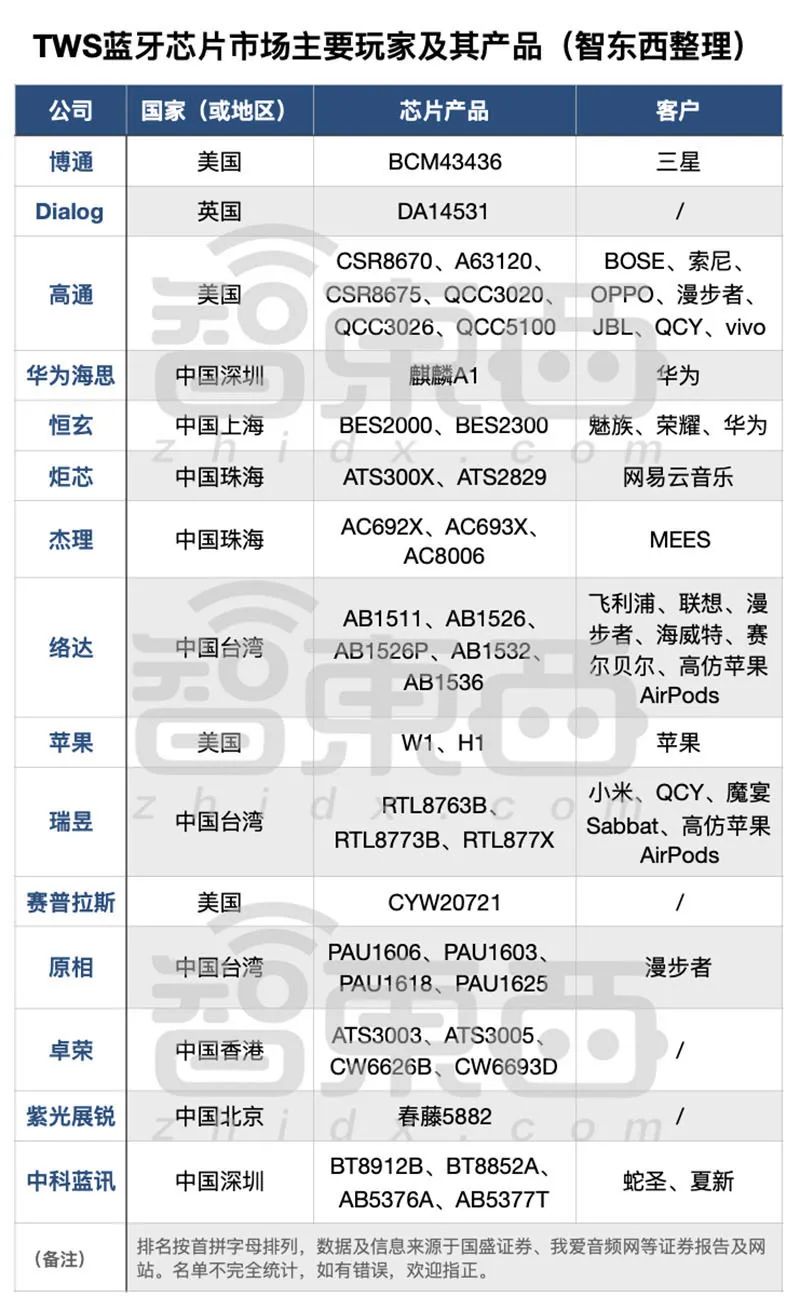
▲ Some major players in the TWS Bluetooth chip market
(1) Mid-to-high-end market: Tier 1 mobile phone and chip makers are on the rise
1. Apple: H1 chip computing power is comparable to iPhone 4
Relying on the first generation of AirPods equipped with W1 chips After knocking on the door of the TWS headset market, Apple is working harder on the development of Bluetooth chips.
The AirPods Pro introduced by Apple last year uses a self-developed Bluetooth chip named H1. The H1 Bluetooth chip supports the Bluetooth 5.1 standard. Compared with the W1 chip, H1 has also improved its performance in terms of connection, battery life and power consumption to a certain extent.
Among them, the conversion speed between devices has been increased by 2 times, the incoming call connection speed has been increased by 1.5 times, and the delay has been reduced by 30%. At the same time, The H1 chip has the same computing power as the A4 chip mounted on the iPhone 4 in its early years. But apart from that, Apple did not disclose more information about H1.
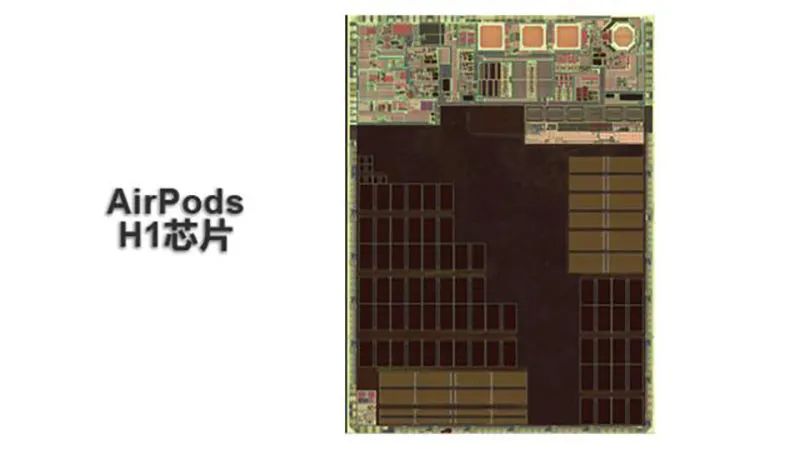
2. Qualcomm: Self-developed true wireless stereo technology
In the field of TWS headsets, in 2018 Qualcomm launched a variety of Bluetooth chips such as CSR8675, QCC3026 and QCC5100.
Among them, the CSR8675 chip supports the Bluetooth V5.0 standard and uses active noise reduction (ANC) technology. It is Qualcomm ’s first Bluetooth audio system-level chip with integrated ANC function, which further improves the sound quality and noise reduction effect . At present, this chip has been used in Sony’s WF-SP700N headset released in 2018.
Although Qualcomm QCC3026 also supports the Bluetooth V5.0 standard, it does not use active noise reduction technology like CSR8675. In addition,QCC3026 uses Qualcomm TrueWireless stereo technology, which reduces the power consumption of the chip, and also improves performance and cost performance. This chip is used by Edifier and OPPO O-Free Bluetooth headsets.
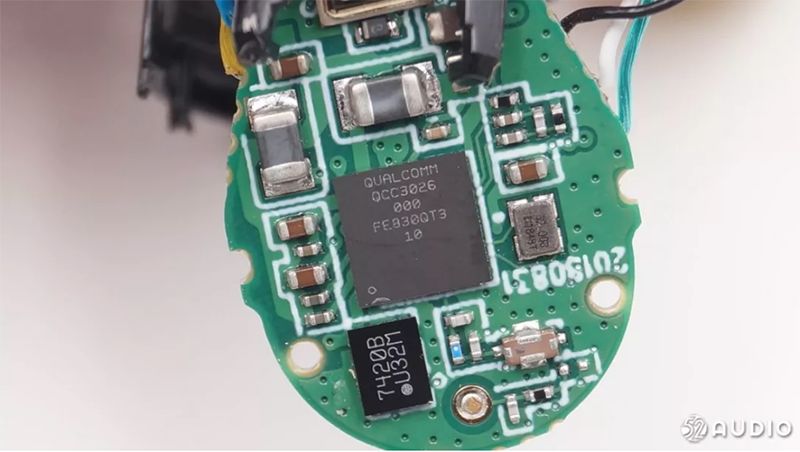
3. Huawei Hisilicon: 50% lower power consumption than Apple H1
Huawei’s Freebuds 3 true wireless headsets launched in 2019 are equipped with HiSilicon’s self-developed Kirin A1 Bluetooth chip.
It is understood that the Kirin A1 chip supports Bluetooth 5.1 and Bluetooth Low Power 5.1 dual standards, which greatly enhances the chip’s anti-interference ability, noise reduction ability and sound quality, and realizes dual-channel Bluetooth link.
Huawei said that compared with the Apple H1 chip, the Kirin A1 chip has a delay of 190mm, a 50% reduction in power consumption, and a 30% increase in performance. The Freebuds 3 headphones shipped more than a million pairs within 100 days of their domestic launch.
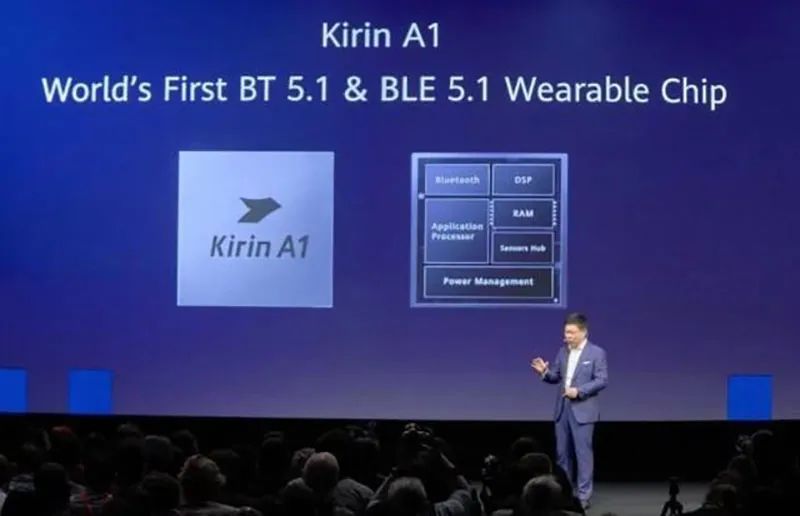
(II) Low-end market: Extensive layout for traditional chip players
1. Rota: Supports Bluetooth 5.0 + Bluetooth Enhanced Rate
Roda was established in 2001, and is Further lay out the Internet of Things market, and purchased a power amplifier (PA) company for $ 1.3 billion in 2017.
In the field of Bluetooth chips, Rota has developed a variety of Bluetooth chips such as AB1526P, AB1532 and AB1536, and customers cover Philips, Lenovo, Edifiers andHewitt and other manufacturers.
Among them, the AB1532 chip supports Bluetooth 5.0 + EDR (Enhanced Data Rate) and built-in high-performance signal processing (DSP), which adds low-power voice wake-up. In terms of sound quality, it also supports High-Res high-resolution music and high- and low-frequency automatic compensation, and supports multiple MICs.
2. Hengxuan: 28nm process, BGA packaging technology
Compared to Roda, Hengxuan, founded in 2015, is a relatively young IC design company that mainly develops RF SOC chips for wireless audio platforms.
For the TWS headset market, Hengxuan launched the BES2000 series chip in 2016 and also released the BES2300 Bluetooth chip in 2018. Huawei Freebuds, Huawei Freebuds 2, Honor FlyPods and Meizu POP TWS headsets are all Adopt its solution.
It is reported that BES2300 uses 28nm process technology and BGA (Ball Grid Array) packaging technology, which supports external sensor devices and eMMC flash memory. In addition, it also supports the Bluetooth 5.0 standard, as well as low-frequency forwarding technology and dual-mode Bluetooth 4.2. It adopts an adaptive active noise reduction scheme. The technology supports the third-generation FWS full wireless stereo technology, dual microphones, etc.
3. Ziguang Zhanrui: TWS chip new players, delay reduced by more than 30%
As an important IC design and R & D manufacturer in China, it has a long-term accumulation and experience in the field of baseband chips, AIoT chips and wireless connection chips.
In 2019, Ziguang Zhanrui officially launched the Ivy 5882 Bluetooth chip, which supports the Bluetooth 5.0 standard, has low power consumption performance, and has a continuous playback life of more than 4 hours. In terms of latency, Ivy 5882’s binaural latency has been reduced by more than 30% compared to the market average. At the same time, the chip also has a dual main ear effect, which supports seamless switching, further improving the user’s switching experience.
It is understood that related products equipped with Ivy 5882 Bluetooth chip have been mass-produced in 2019, but Ziguang Zhanrui did not disclose specific customer information.
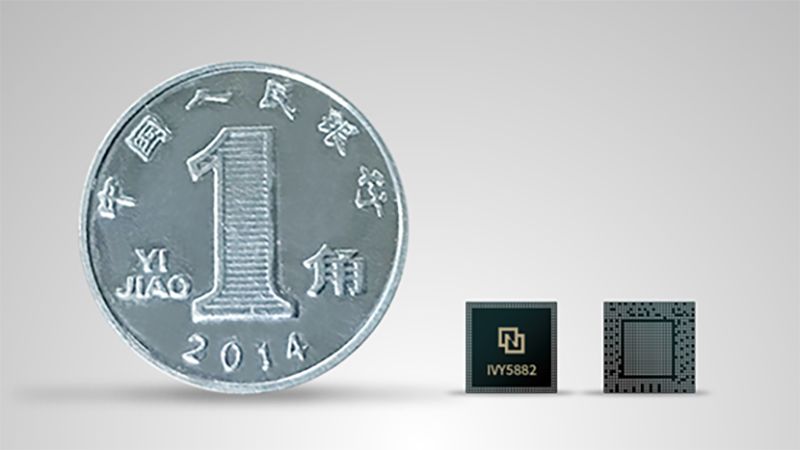
(C) Low-end market: Low-cost fight in Huaqiang North camp
1. Jerry: using intelligent lossless noise reduction algorithm
Jerry Technology, founded in 2010, designs and develops wireless connection chips for IoT terminal markets such as AI smart speakers, Bluetooth headsets, and Bluetooth speakers. In response to the TWS Bluetooth headset market, Jerry has released a variety of Bluetooth chip solutions such as AC6907A, AC693X and AC6936D since 2016.
Among them, AC693X supports Bluetooth 5.0 and Bluetooth Low Energy (BLE) 5.0 standards. In terms of performance, the chip has master-slave switching and bilateral call functions, and uses ultra-small packaging and charge management technology to further reduce chip power consumption.
On the other hand, AC6936D chip supports Bluetooth 5.1 standard, adopts intelligent lossless noise reduction algorithm, can realize binaural high-definition calls and seamless master-slave switching, and the power consumption is 6mA. It is reported that the MEES F2 headset equipped with Jerry AC6936D chip won the German Red Dot Design Award in 2019.
2. Zhongke Lanxun: support dual Bluetooth standards
Although it was established 6 years later than Jerry, the momentum of Zhongke Lanxun’s subsequent rise is equally important. Zhongke Lanxun mainly targets high-performance headphones, audio and the Internet of Things, and its customers cover manufacturers such as Philips, Audio-Technica, Sony and Hivi.
In the field of Bluetooth chips, Zhongke Lanxun has launched a variety of chip solutions such as BT8912B, BT8852A, AB5376A and AB5377T. Among them, the BT8912B chip supports Bluetooth 5.0 and BLE standards, supports GPIO (General Purpose Input / Output) wake-up or interrupt, and master-slave switching.
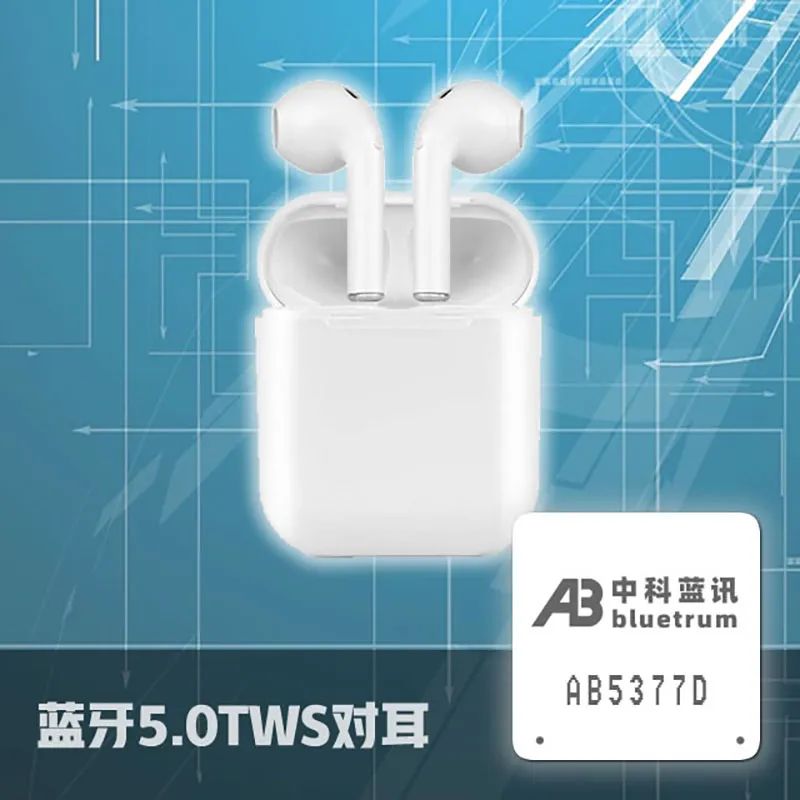

According to the market research organization Counterpoint Research, the global shipment of TWS Bluetooth headsets will reach 230 million pairs in 2020, an increase of 91.6% year-on-year. At the same time, the compound annual growth rate from 2019 to 2022 will remain at 80%, showing a blowout development.
In the recent years when the TWS headset market has doubled, downstream terminal manufacturers have swarmed in, and at the same time, it has brought huge demand for Bluetooth chips to upstream chip manufacturers, attracting a large number of players.
According to the data of Guosheng Securities’ market research report in 2019, As of April 2019, there are already Qualcomm, Rota, Realtek, Hengxuan and Torch chips in the world. The eight major chip manufacturers have launched a total of 18 TWS Bluetooth chip solutions.
From a system perspective, the TWS Bluetooth chip is mainly divided into two markets. One is the Apple of the W series and the H series of its own. It has no doubt that it has won half of the market. The other is ecological. Complex and demanding Android market for compatibility.
From the perspective of the market, before 2018, the Apple AirPods series occupied more than 70% of the market share. Although in 2019, as more players joined, Apple’s share was diluted, but it still occupied more than half of the market.
The Bluetooth chip of the TWS headset is undoubtedly a fragrant piece, which has attracted domestic and foreign chip manufacturers to settle and compete with each other. However, because there is always a technological gap at home and abroad, the Bluetooth chip solution can be divided into three forces from the perspective of market positioning.

(1) Mid-to-high-end market: Tier 1 mobile phone and chip makers are on the rise
1. Apple: H1 chip computing power is comparable to iPhone 4
Relying on the first generation of AirPods equipped with W1 chips After knocking on the door of the TWS headset market, Apple is working harder on the development of Bluetooth chips.
The AirPods Pro introduced by Apple last year uses a self-developed Bluetooth chip named H1. The H1 Bluetooth chip supports the Bluetooth 5.1 standard. Compared with the W1 chip, H1 has also improved its performance in terms of connection, battery life and power consumption to a certain extent.
Among them, the conversion speed between devices has been increased by 2 times, the incoming call connection speed has been increased by 1.5 times, and the delay has been reduced by 30%. At the same time, The H1 chip has the same computing power as the A4 chip mounted on the iPhone 4 in its early years. But apart from that, Apple did not disclose more information about H1.

2. Qualcomm: Self-developed true wireless stereo technology
In the field of TWS headsets, in 2018 Qualcomm launched a variety of Bluetooth chips such as CSR8675, QCC3026 and QCC5100.
Among them, the CSR8675 chip supports the Bluetooth V5.0 standard and uses active noise reduction (ANC) technology. It is Qualcomm ’s first Bluetooth audio system-level chip with integrated ANC function, which further improves the sound quality and noise reduction effect . At present, this chip has been used in Sony’s WF-SP700N headset released in 2018.
Although Qualcomm QCC3026 also supports the Bluetooth V5.0 standard, it does not use active noise reduction technology like CSR8675. In addition,QCC3026 uses Qualcomm TrueWireless stereo technology, which reduces the power consumption of the chip, and also improves performance and cost performance. This chip is used by Edifier and OPPO O-Free Bluetooth headsets.

3. Huawei Hisilicon: 50% lower power consumption than Apple H1
Huawei’s Freebuds 3 true wireless headsets launched in 2019 are equipped with HiSilicon’s self-developed Kirin A1 Bluetooth chip.
It is understood that the Kirin A1 chip supports Bluetooth 5.1 and Bluetooth Low Power 5.1 dual standards, which greatly enhances the chip’s anti-interference ability, noise reduction ability and sound quality, and realizes dual-channel Bluetooth link.
Huawei said that compared with the Apple H1 chip, the Kirin A1 chip has a delay of 190mm, a 50% reduction in power consumption, and a 30% increase in performance. The Freebuds 3 headphones shipped more than a million pairs within 100 days of their domestic launch.

(II) Low-end market: Extensive layout for traditional chip players
1. Rota: Supports Bluetooth 5.0 + Bluetooth Enhanced Rate
Roda was established in 2001, and is Further lay out the Internet of Things market, and purchased a power amplifier (PA) company for $ 1.3 billion in 2017.
In the field of Bluetooth chips, Rota has developed a variety of Bluetooth chips such as AB1526P, AB1532 and AB1536, and customers cover Philips, Lenovo, Edifiers andHewitt and other manufacturers.
Among them, the AB1532 chip supports Bluetooth 5.0 + EDR (Enhanced Data Rate) and built-in high-performance signal processing (DSP), which adds low-power voice wake-up. In terms of sound quality, it also supports High-Res high-resolution music and high- and low-frequency automatic compensation, and supports multiple MICs.
2. Hengxuan: 28nm process, BGA packaging technology
Compared to Roda, Hengxuan, founded in 2015, is a relatively young IC design company that mainly develops RF SOC chips for wireless audio platforms.
For the TWS headset market, Hengxuan launched the BES2000 series chip in 2016 and also released the BES2300 Bluetooth chip in 2018. Huawei Freebuds, Huawei Freebuds 2, Honor FlyPods and Meizu POP TWS headsets are all Adopt its solution.
It is reported that BES2300 uses 28nm process technology and BGA (Ball Grid Array) packaging technology, which supports external sensor devices and eMMC flash memory. In addition, it also supports the Bluetooth 5.0 standard, as well as low-frequency forwarding technology and dual-mode Bluetooth 4.2. It adopts an adaptive active noise reduction scheme. The technology supports the third-generation FWS full wireless stereo technology, dual microphones, etc.
3. Ziguang Zhanrui: TWS chip new players, delay reduced by more than 30%
As an important IC design and R & D manufacturer in China, it has a long-term accumulation and experience in the field of baseband chips, AIoT chips and wireless connection chips.
In 2019, Ziguang Zhanrui officially launched the Ivy 5882 Bluetooth chip, which supports the Bluetooth 5.0 standard, has low power consumption performance, and has a continuous playback life of more than 4 hours. In terms of latency, Ivy 5882’s binaural latency has been reduced by more than 30% compared to the market average. At the same time, the chip also has a dual main ear effect, which supports seamless switching, further improving the user’s switching experience.
It is understood that related products equipped with Ivy 5882 Bluetooth chip have been mass-produced in 2019, but Ziguang Zhanrui did not disclose specific customer information.

(C) Low-end market: Low-cost fight in Huaqiang North camp
1. Jerry: using intelligent lossless noise reduction algorithm
Jerry Technology, founded in 2010, designs and develops wireless connection chips for IoT terminal markets such as AI smart speakers, Bluetooth headsets, and Bluetooth speakers. In response to the TWS Bluetooth headset market, Jerry has released a variety of Bluetooth chip solutions such as AC6907A, AC693X and AC6936D since 2016.
Among them, AC693X supports Bluetooth 5.0 and Bluetooth Low Energy (BLE) 5.0 standards. In terms of performance, the chip has master-slave switching and bilateral call functions, and uses ultra-small packaging and charge management technology to further reduce chip power consumption.
On the other hand, AC6936D chip supports Bluetooth 5.1 standard, adopts intelligent lossless noise reduction algorithm, can realize binaural high-definition calls and seamless master-slave switching, and the power consumption is 6mA. It is reported that the MEES F2 headset equipped with Jerry AC6936D chip won the German Red Dot Design Award in 2019.
2. Zhongke Lanxun: support dual Bluetooth standards
Although it was established 6 years later than Jerry, the momentum of Zhongke Lanxun’s subsequent rise is equally important. Zhongke Lanxun mainly targets high-performance headphones, audio and the Internet of Things, and its customers cover manufacturers such as Philips, Audio-Technica, Sony and Hivi.
In the field of Bluetooth chips, Zhongke Lanxun has launched a variety of chip solutions such as BT8912B, BT8852A, AB5376A and AB5377T. Among them, the BT8912B chip supports Bluetooth 5.0 and BLE standards, supports GPIO (General Purpose Input / Output) wake-up or interrupt, and master-slave switching.




1. Rota: Supports Bluetooth 5.0 + Bluetooth Enhanced Rate
Roda was established in 2001, and is Further lay out the Internet of Things market, and purchased a power amplifier (PA) company for $ 1.3 billion in 2017.
In the field of Bluetooth chips, Rota has developed a variety of Bluetooth chips such as AB1526P, AB1532 and AB1536, and customers cover Philips, Lenovo, Edifiers andHewitt and other manufacturers.
Among them, the AB1532 chip supports Bluetooth 5.0 + EDR (Enhanced Data Rate) and built-in high-performance signal processing (DSP), which adds low-power voice wake-up. In terms of sound quality, it also supports High-Res high-resolution music and high- and low-frequency automatic compensation, and supports multiple MICs.
2. Hengxuan: 28nm process, BGA packaging technology
Compared to Roda, Hengxuan, founded in 2015, is a relatively young IC design company that mainly develops RF SOC chips for wireless audio platforms.
For the TWS headset market, Hengxuan launched the BES2000 series chip in 2016 and also released the BES2300 Bluetooth chip in 2018. Huawei Freebuds, Huawei Freebuds 2, Honor FlyPods and Meizu POP TWS headsets are all Adopt its solution.
It is reported that BES2300 uses 28nm process technology and BGA (Ball Grid Array) packaging technology, which supports external sensor devices and eMMC flash memory. In addition, it also supports the Bluetooth 5.0 standard, as well as low-frequency forwarding technology and dual-mode Bluetooth 4.2. It adopts an adaptive active noise reduction scheme. The technology supports the third-generation FWS full wireless stereo technology, dual microphones, etc.
3. Ziguang Zhanrui: TWS chip new players, delay reduced by more than 30%
As an important IC design and R & D manufacturer in China, it has a long-term accumulation and experience in the field of baseband chips, AIoT chips and wireless connection chips.
In 2019, Ziguang Zhanrui officially launched the Ivy 5882 Bluetooth chip, which supports the Bluetooth 5.0 standard, has low power consumption performance, and has a continuous playback life of more than 4 hours. In terms of latency, Ivy 5882’s binaural latency has been reduced by more than 30% compared to the market average. At the same time, the chip also has a dual main ear effect, which supports seamless switching, further improving the user’s switching experience.
It is understood that related products equipped with Ivy 5882 Bluetooth chip have been mass-produced in 2019, but Ziguang Zhanrui did not disclose specific customer information.

(C) Low-end market: Low-cost fight in Huaqiang North camp
1. Jerry: using intelligent lossless noise reduction algorithm
Jerry Technology, founded in 2010, designs and develops wireless connection chips for IoT terminal markets such as AI smart speakers, Bluetooth headsets, and Bluetooth speakers. In response to the TWS Bluetooth headset market, Jerry has released a variety of Bluetooth chip solutions such as AC6907A, AC693X and AC6936D since 2016.
Among them, AC693X supports Bluetooth 5.0 and Bluetooth Low Energy (BLE) 5.0 standards. In terms of performance, the chip has master-slave switching and bilateral call functions, and uses ultra-small packaging and charge management technology to further reduce chip power consumption.
On the other hand, AC6936D chip supports Bluetooth 5.1 standard, adopts intelligent lossless noise reduction algorithm, can realize binaural high-definition calls and seamless master-slave switching, and the power consumption is 6mA. It is reported that the MEES F2 headset equipped with Jerry AC6936D chip won the German Red Dot Design Award in 2019.
2. Zhongke Lanxun: support dual Bluetooth standards
Although it was established 6 years later than Jerry, the momentum of Zhongke Lanxun’s subsequent rise is equally important. Zhongke Lanxun mainly targets high-performance headphones, audio and the Internet of Things, and its customers cover manufacturers such as Philips, Audio-Technica, Sony and Hivi.
In the field of Bluetooth chips, Zhongke Lanxun has launched a variety of chip solutions such as BT8912B, BT8852A, AB5376A and AB5377T. Among them, the BT8912B chip supports Bluetooth 5.0 and BLE standards, supports GPIO (General Purpose Input / Output) wake-up or interrupt, and master-slave switching.

